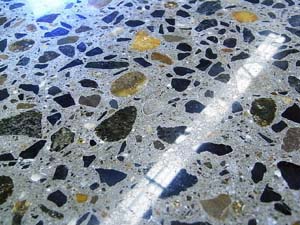Note: Before selecting any structural components for your dwelling it is advised that you consult with a Structural Engineer and a builder. In addition you can read the Australian Standards available for all areas of construction.
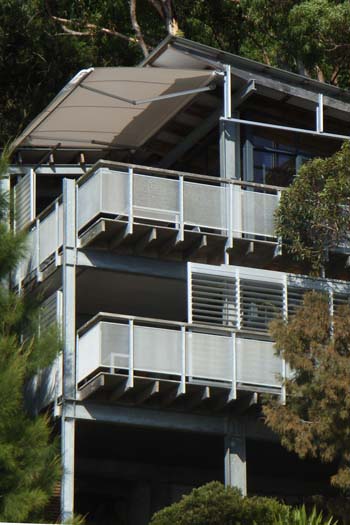
Steel pole house with exposed structure
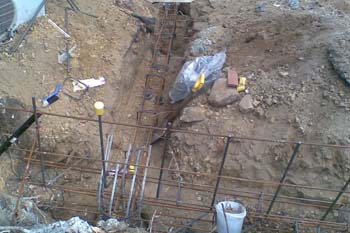
Trenches with reinforcement for strip footing
The type of footings used for a new home will be suggested by the home designer with possible consultation with a geo-tech consultant. The factors that influence the type of footings are:
- Weight of building
- Wall construction type and height
- Soil type
- Slope of the block
- Budget
- Drainage requirements on the block
There are five main types of footings:
Strip Footings
A Strip Footing is a relatively small strip of concrete placed into a trench and reinforced with steel. The footing supports the load of the exterior walls and any interior wall that is load bearing or supports a slab such as for a bathroom. Strip footings can be used for both traditional timber and concrete floors. They are one of the most common footing used in Australia.
Concrete pad footings.
A concrete pad footing is the simplest and cost effective footing used for the vertical support and the transfer of building loads to the ground. These footings are "isolated" ie there is no connection between them. They are also reinforced.
Holes are dug (say 400mm wide x 400mm deep) into the ground and fitted with a reinforcement cage then filed in with a concrete mix to ground level.
Concrete pad footings are used to support light weight timber-framed houses.
Pole Construction (Post and Concrete)
For this type of footing a hole is dug into the ground about 800mm wide x 1600mm deep. A pole is then placed into the hole and ready mixed concrete is back filled around the pole. Pole construction footings do not require steel reinforcement (or an engineer) and are therefore also one of the least expensive footings types.
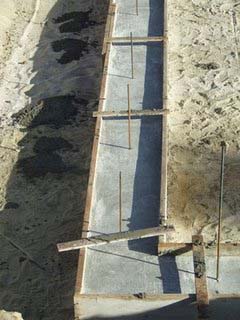
Concrete strip footings
with reinforcement
Pole Construction is the most economical way of constructing a pier/footing on sloping land but engineer's details will be required for the builder and certifying authorities. A few essential considerations are:
- How long the poles will need to be and the spacing?
- What will be the correct height of all poles?
- How far down will the pole will need to penetrate?
- How will the concrete around the pole need to be finished to reduce wood rot?
- What will the diameter of the poles need to be?
- What are the poles are made of (steel or timber)?
Grout Injected Piles
Where it is impossible for a footing to be constructed, a pile which is both pier and footing is used.
This method is only used in unstable or potentially unstable soils such as mud flat estuary areas and beach front etc. Grout injected piles are "isolated" footings and/or piers, which are cement grouted (not concrete) and steel reinforced, with an overall diameter of around 600mm.
The piers are installed by inserting a cork like screw (Metal Auger) attached to a Backhoe in to the ground. The Auger screws all the dirt out of the pier hole that will be around 6 meters in depth. Once all the dirt is removed the grout is injected through the end of the rotating Auger into the hole. As the hole fills with grout the rotating Auger is slowly removed ensuring no dirt collapses back into the hole. The Auger machine drills out the pier holes with minimal disturbance to adjoining soil and structures. Mini piles use the same process and materials as grout injected piles but are around 200mm in diameter
Timber Piles
Timbers piles are a more cost affective method of constructing structural piles. Timber piles are long timber poles around 6000mm in length and 400mm in diameter that are hammered deep into the ground by a pile driving rig (big hammer). The piles are driven into the ground their full length or until the pile hits bedrock. If the pile hits a floating bolder it will skew in the ground but the pile will be amply stable to support a floor structure. Pile driving vibration can disturb adjacent buildings, resulting in cracking, failure and even collapse.
Floor structures
Pier and Beam construction
Piers are the most common and cost effective type of floor support system used in NSW, and to a lesser extent, other states. The piers sit directly onto the concrete pad footings and can be:
- brick piers
- timber stumps on galvanised "shoes"
- steel posts that are bolted in each corner onto the pad footing with a "Dynabolt"
- precast reinforced concrete
- core filled concrete block work
Bearers and joists
The bearers rest on top on the piers and usually run the direction of the longest wall. Joists are then laid in the opposite direction and are often clad in chipboard before the final floor is installed at the end of the construction process. Do not forget at this time to allow access for bathroom and kitchen piping.
Physical termite barriers like "Termimesh" (stainless steel mesh) or "Graniteguard" (a fine dry granular product that when compacted stops termite entry) will be located between all connections to timber flooring members. These connections materials include concrete, steel and brick.
Concrete Slabs
There are two main types of ground slabs:
Raft or Ground Slab
The steel reinforced raft slab is the simplest and most common slab construction available. In each case:
- Trenches about 450mm wide x 450mm deep are dug around the perimeter of external walls and under load bearing walls
- Reinforcement cages are laid in the trenches and reinforcement bars are also laid at this time, and turned up to pass above the top of the strip footing to accommodate later slab structure
- Ready mixed concrete is poured into the trench to ground level with vertical reinforcement bars protruding up to be formed with the floor slab.
- Moisture protection, termite protection, electrical conduit, drainage and sewerage pipes for bathrooms and kitchens are positioned.
- Form work for the slab is then erected along the outer edges of the building footprint and on top of the cured concrete footings.
- Steel reinforcement is laid for the slab
- Concrete is poured in one operation creating a slab that covers the entire floor area.
Waffle Slab
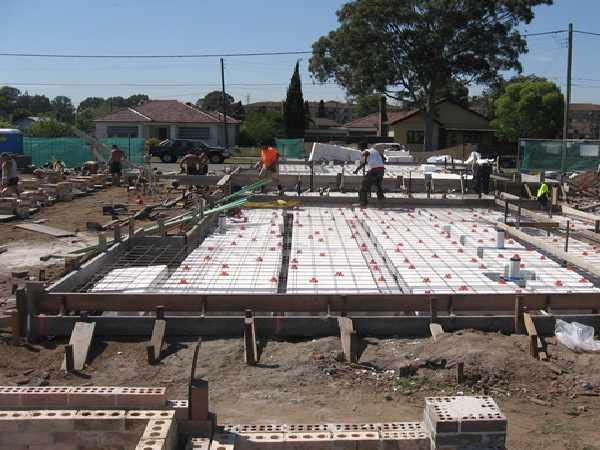
Waffle slab example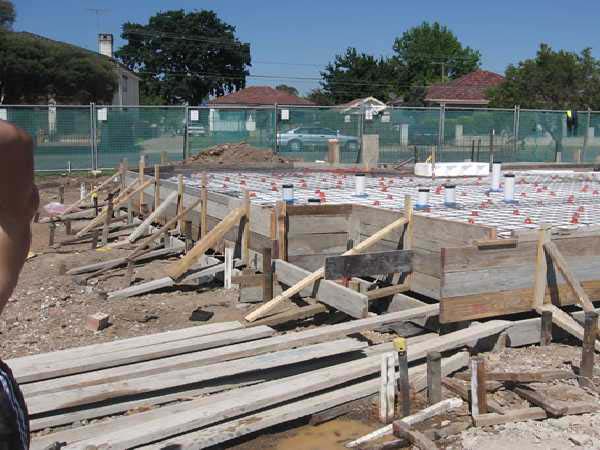
A waffle slab is like an egg box arrangement i.e. it is not a solid slab.
Trenches are dug perpendicular to the perimeter of the building's footprint. Steel reinforcement is laid in the trenches to give it a rigid structure. Large polystyrene squares are laid between beams (instead of aggregate and sand). Concrete is poured in one process (rather than the separate pours in for a Raft Slab)
Waffle slabs use less concrete, however if well engineered, they can be stronger than a solid slab .
Suspended slab
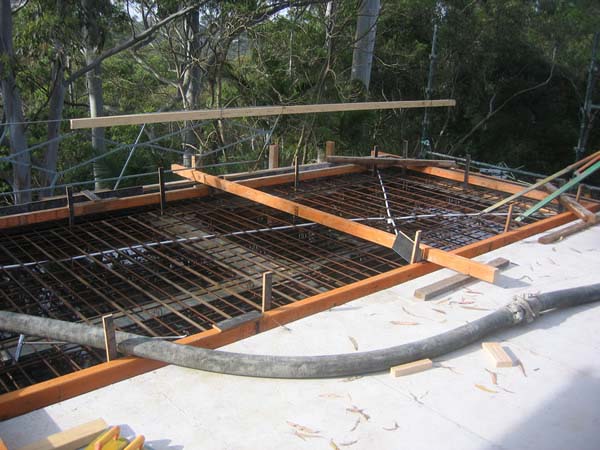
Suspended slab example
A suspended slab is raised off the ground and has an accessible sub-floor area. In a residential situation the slab is around 200mm thick and is supported by external sub-floor walls of brick or concrete block etc. The slab is also supported by free standing brick or concrete piers.
To reduce the concrete slab thickness a sheet metal product such as 'Bondek' can be laid as not only the form work but also a structural component. This steel sheet product is designed to take the pouring and curing loads of concrete and is very strong. 'Bondek' can reduce slab thickness hence reducing concrete costs. This sheeting is not removed and remains in the structure for the life of the building.
The building process series of articles
This article is one in a series which covers everything from laying the foundations to selecting the finishes. Click on the following link if you would like to learn more about the building process for new houses.
Flooring articles
Selecting flooring. Choosing the right floor for you in 4 easy steps.
Choosing a timber floor. When it comes to choosing timber flooring, here are the six most important steps to consider.
Did you know that timber flooring has a limited life? Read more on the subject in this article: Timber Floor Sanding & Polishing .
Polished concrete floors. If we are talking ‘flavour of the year’ in architectural flooring, polished concrete would have to be ‘it’. Not yet common place in the mass Australian housing market
